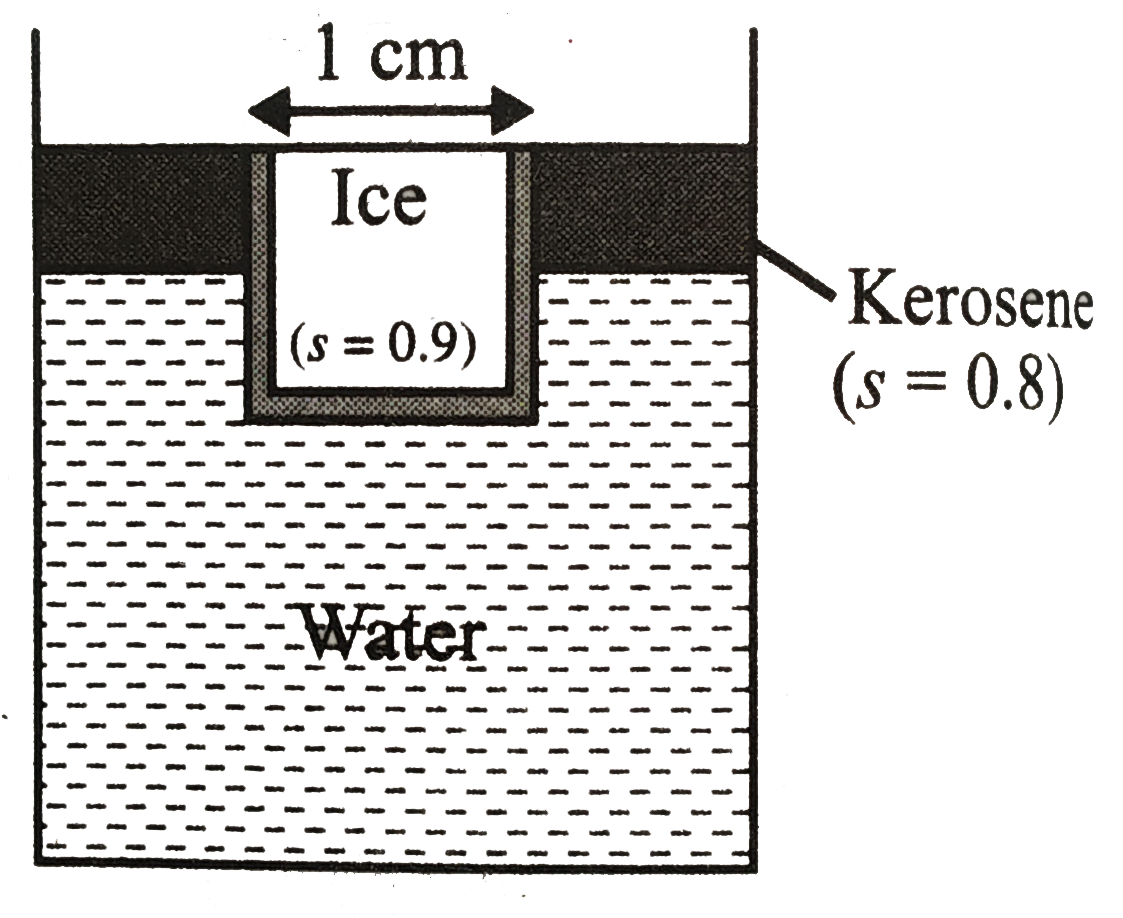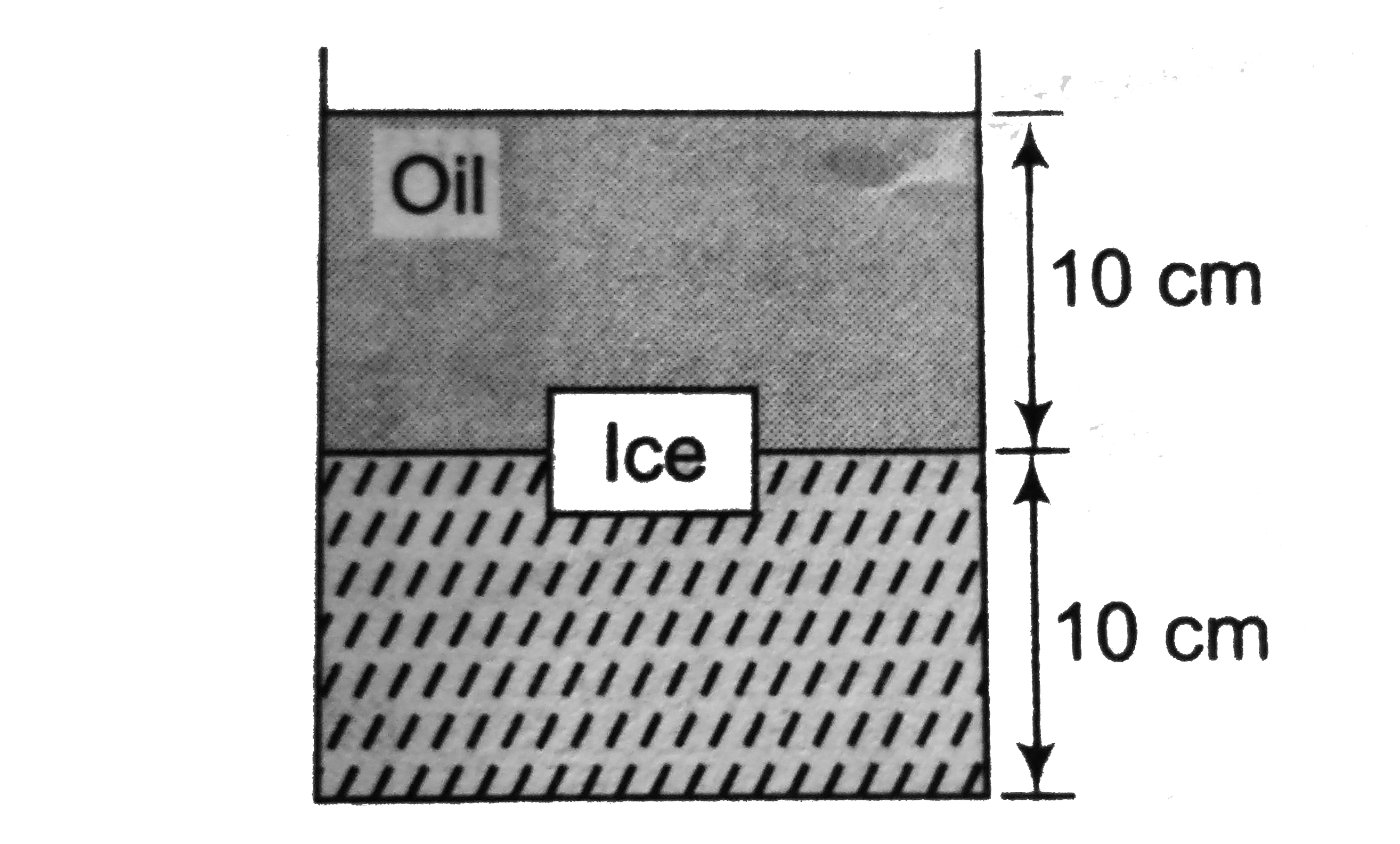An ice cube of side 1cm is floating at the interface of kerosene and water in a beaker of base area 10cm2. The level of kerosene is just covering the top surface of the ice cube.
a. Find the depth of submergence in the kerosene and that in the water.
b. Find the change in the total level of the liquid when the whole ice melts into water.

The correct Answer is:0.1mm
According to the condition of floating
0.8ρwghk+ρwghw=0.9ρwgh……….i
where hk and hw are the submerged depth of the ice in the kerosene and water, respectively
hk+hw=h…….ii
Solving eqn i and ii we get hk=0.5cm,h2=0.5cm
b. 1cm3 ice melts−−→0.9cm3 water
After melting the ice 0.5cm3 of water will be occupied by the kerosene. Therefore the fall in the level of kerosene is △hk=0.5A.
Out of 0.9cm3 of water formed 0.5cm3 of water will be filled in the vacant part of ice and remaining (0.9−0.5)=0.4cm3 of water will be available to increase the level of water.
Rise in the level of water is △hw=0.9−0.5A=0.4A
Hence, the net fall in the overall level is
△h=0.1A=0.110=0.01mm
Topper's Solved these Questions
- FLUID MECHANICSBOOK - CENGAGE PHYSICSCHAPTER - FLUID MECHANICSEXERCISE - Single Correct
95 Videos
- FLUID MECHANICSBOOK - CENGAGE PHYSICSCHAPTER - FLUID MECHANICSEXERCISE - Multipe Correct
15 Videos
- FLUID MECHANICSBOOK - CENGAGE PHYSICSCHAPTER - FLUID MECHANICSEXERCISE - Exercise 4.4
10 Videos
- DIMENSIONS & MEASUREMENTBOOK - CENGAGE PHYSICSCHAPTER - DIMENSIONS & MEASUREMENTEXERCISE - Integer
2 Videos
- GRAVITATIONBOOK - CENGAGE PHYSICSCHAPTER - GRAVITATIONEXERCISE - INTEGER_TYPE
1 Videos
Similar Questions
A block of ice is floating in a liquid of specific gravity 1.2 contained in the beaker. What will be the effect on the level of liquid in the beaker when the whole ice melts?
View SolutionA wooden cube (density 0.5 gm/c c) of side 10 cm floating in water kept in a cylindrical beaker of base area 1500cm2. When a mass m is kept on the wooden block the level of water rises in the beaker by 2mm. Find the mass m.
View Solution
Knowledge Check
Ice floats on the surface of water because
Ait is heavier than waterBthe density of water is same as that of iceCice is lighter than waterDnone of theseA piece of ice is floating in a beaker containing thick sugar solution of water. As the ice melts, the total level of he liquid
AincreasesBdecreasesCremains unchangedDinsufficent dataAn ice cube containing a galss ball is floating on the surface of water contained in a trough. The whole of the ice melts, the level of water in the trough
ArisesBfallsCremains unchangedDfirst falls and then rises
A cube of ice is floating in a liquid of relative density 1.25 contained in a beaker . When the ice melts, the level of the liquid in the beaker ?
View SolutionA piece of ice is floating in a glass vessel filled with water. How will the level of water in the vessel change when the ice melts ?
View SolutionAn ice cube containing a piece of lead floats in water What would be the effect on the level of water if the ice cube melts ?
View SolutionThe density of ice xcm−3 and that of water is ygcm−3. What is the change in volume when mg of ice melts?
View SolutionA cubical block of side 10cm floats at the interface of an oil and water as shown in the figure. The density of oil is 0.6gcm−3 and the lower face of ice cube is 2cm below the interface. The pressure above that of the atomosphere at the lower face of the block is

View Solution
